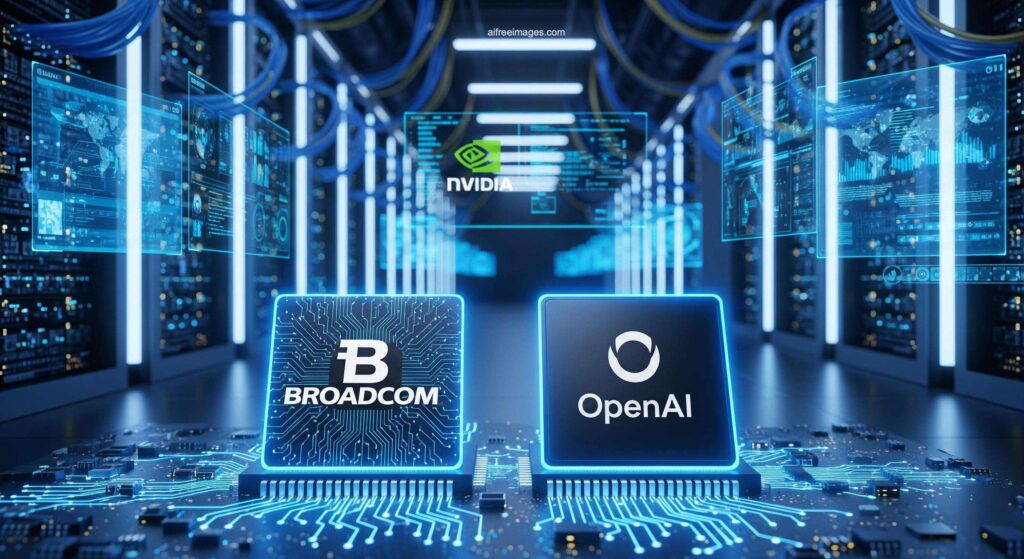OpenAI, the company behind ChatGPT and the GPT-5 model, is about to take a strategic step in the competitive artificial intelligence market: producing its own large-scale AI chips starting in 2026. According to the Financial Times, the company has designed a specialized processor in collaboration with Broadcom, a U.S.-based semiconductor manufacturer, with a contract valued at approximately $10 billion.
This move aims to address two immediate challenges: the exponential increase in computational power demand and its heavy reliance on NVIDIA, the undisputed leader in the market with its H100 GPUs and the new Blackwell architecture.
From GPU shortages to self-sufficiency
The idea isn’t new. As early as 2023, Reuters reported that OpenAI was exploring the development of its own hardware after CEO Sam Altman noted that GPU supply constraints were affecting the speed and reliability of the company’s services. At that time, OpenAI began discussions with Broadcom and Taiwan Semiconductor Manufacturing Company (TSMC), though it’s not confirmed whether the collaboration with the Taiwanese foundry is still ongoing.
The commitment has gained momentum in recent months. After the launch of GPT-5, Altman publicly acknowledged that the company needed to double its computing capacity in just five months to meet the demand for ChatGPT and its enterprise APIs.
The new “XPUs”
The chip under development, tentatively named “XPU”, falls into the category of purpose-built accelerators for AI. These processors are designed to train and run large language models more efficiently than a conventional GPU. According to the Financial Times, OpenAI does not plan to sell them commercially but intends to use them exclusively within its cloud infrastructure.
This decision could lead to cost savings in the medium term. Although the initial investment is high, controlling hardware design and production will enable the company to optimize performance, mitigate future supply crises, and strengthen its technological independence from NVIDIA.
A market dominated by NVIDIA
OpenAI’s strategy comes amid NVIDIA’s continued dominance in the industry. In Q2 2025, the company reported a 56% increase in year-over-year revenue, even without selling H20 chips in China due to export restrictions.
Nevertheless, industry analysts suggest that custom chips—such as OpenAI’s XPUs, Google’s TPUs, or Amazon’s Trainium—will progressively claim a larger market share, especially among tech giants seeking to control their supply chains.
Long-term strategy
Beyond current challenges, OpenAI’s move reflects a profound industry shift: large software and AI companies are becoming hardware manufacturers. Designing their own chips not only secures computing capacity but also allows tailoring architectures to the specific needs of their AI models, from energy efficiency to scalability.
The question now is whether OpenAI can execute such an ambitious project in the complex semiconductor sector, which is dominated by players with decades of experience.
Frequently Asked Questions (FAQ)
What is an XPU?
It is the provisional name for the AI chips developed by OpenAI in collaboration with Broadcom. They are purpose-built accelerators for training and executing language models, similar in concept to Google’s TPUs.
Will they compete directly with NVIDIA?
Not in the short term. XPUs will be exclusively used for OpenAI’s infrastructure, while NVIDIA will continue leading the global AI GPU market.
What role does Broadcom play?
Broadcom is OpenAI’s technology partner in this project. According to the Financial Times, the manufacturer has received orders valued at $10 billion, though no technical details about the chip architecture have been disclosed.
Why does OpenAI want to produce its own chips?
To reduce reliance on NVIDIA, ensure hardware availability amid increasing demand, and—long-term—to save costs by having full control over the design and manufacturing of its processors.
via: engadget

